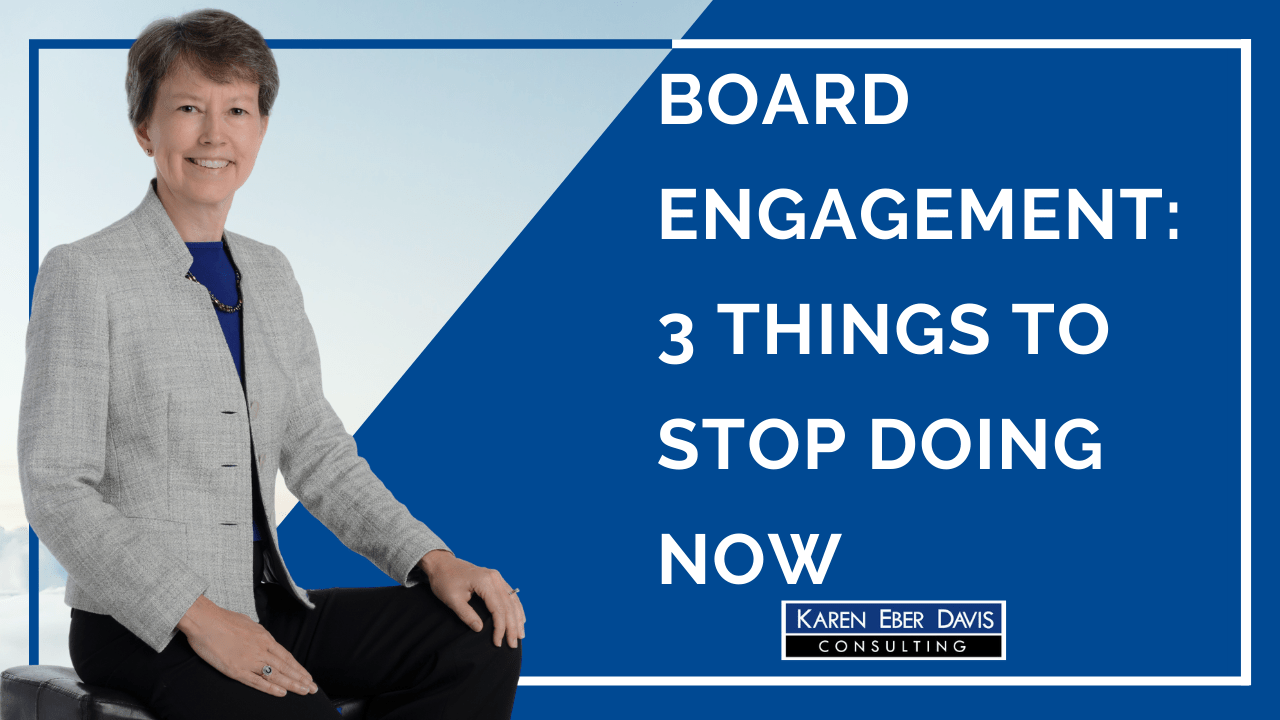
Board Engagement: 3 Things to Stop Doing Now
This video (3:35 minutes) invites you to stop doing three things that contribute to disengagement and move toward engagement. You can improve your nonprofit’s board engagement.
Chapters of Board Engagement: 3 Things to Stop Doing Now
0:00 The Situation
0:29 Stop this at Meetings
1:18 Stop this Before and After Meetings
2:44 If You Do Nothing Else
For more answers, check out Karen’s Nonprofit CEO Library.
For solutions delivered to your inbox sign up for Karen’s CEO Solutions.
Transcript of Board Engagement: 3 Things to Stop Doing Now
How can you improve your board’s engagement? In my years advising nonprofit CEOs, I found there are two kinds of boards—those that tend to micromanage and those that are disengaged. Of the two challenges, the one clients struggle with the most is the disengaged board because underneath, you have to wonder if the board members care about your cause.
Stop this at Meetings
So, what can you stop doing to avoid disengaging your board? First of all, when you see your boards disengaged during a meeting, stop. If they’re sitting like couch potatoes watching a Zoom program like they’re watching tv, do you hurry up to the next report, or instead, do you stop? And say, “Hey, what’s going on? And, you are all really quiet today, and then you listen and wait.
It will seem like forever but don’t worry, they will respond. If they don’t, you can offer them some choices. Is this topic something you don’t care about? Have we already decided it, or is there something else going on in the world we just can’t concentrate right now? So find out. Get some feedback.
To avoid a disengaged board, stop ignoring the disengaged behavior and ask for feedback.
Stop this Before and After Meetings
The second thing to avoid doing is to stop treating your board meetings like they are standalone events. Instead, think about your boards as an ongoing piece of music that you are conducting. And you’re looking for individual voices to speak up. You’re looking for times of silence and quiet times, and then sometimes they’re loud-where, everyone’s engaged.
So as you’re doing that–to do practically think about how you can use the times between meetings to create some momentum engagement. Ask people to give reports. Perhaps they’re already doing that–but then if you say to that person. “how can we create some questions and discussions around this? Let’s think of some questions I should ask or you should ask at the end of the report. That will engage board members.
Also, think about asking that person or asking someone if they will take the next step. If it will be a meeting, will you facilitate that? So get your next leader involved.
Consider how you might, instead of everyone at the conference table talking together, break up the questions and say, “Okay, everyone go with one other person and talk for five minutes, and we’ll do a share back. So there are many ways to use your experience with your board between meetings to help them be engaged.
So to avoid a disengaged board, use before, after, and during meetings to plan how you will conduct your symphony.
If You Do Nothing Else
Here’s the #1 thing. If you do nothing else from watching this video do this. Stop blaming your board.
If your board’s not engaged, you have a broken partnership. Instead, ask yourself, one of the partners, how you can fix it. Ask the other partner how you can fix it. Work together towards the solution.
Almost all board members get on a board with good intentions. Life gets in the way. Some are unmotivated. Some are less motivated when they get on, but most boards want to succeed, and they want to partner with you to help your mission be accomplished.
How can you fix this? Stop blaming them and move into action. If you like this video, share it with your board chair and get working today on engaging your board.
How you ask for board help is critical, watch this video for more on common blunders asking for board help.
BTW, Karen is available for a mini-consult or more to support you and your board. Click here to email or here to set a time to chat.
Karen Eber Davis is a nonprofit strategic planning consultant who works with visionary leaders committed to taking their organizations to new heights. She offers customized strategies, assessments, and coaching designed to help leaders lead their organizations to achieve their potential. She is the author of 7 Nonprofit Income Streams and Let's Raise Nonprofit Millions Together.
Categories
If you appreciate these Added Value posts, please consider subscribing.
Latest Posts
- The Uncertainty Vortex: How Visionary Nonprofit Leaders Move Forward Without Clarity
- How New Nonprofit CEOs Secure Board Buy-In for Strategic Planning
- How Nonprofit Leader Navigate Crisis with Clarity & Confidence
- One Way AI Can Help You Find a Path Where None Exists
- In Crisis? Resist Cutting Your Ability to Make Income
